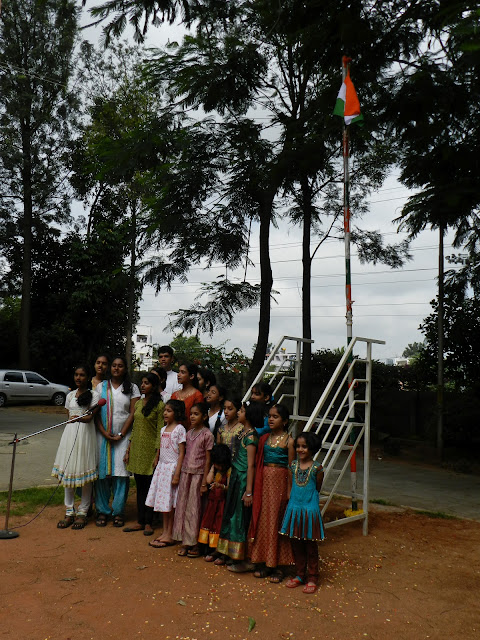In early 2011, we decided to put in a place a dry waste management system in Goodwill Apartments. Our approach has been one of cautious optimism, taking one step at a time to ensure that we build a sound waste collection system.
Waste segregation is of utmost importance in rapidly growing cities like Bangalore. To briefly state why it was so vital, we printed an awareness pamphlet that we handed out to all residents of our apartment. I'm quoting a paragraph from that pamphlet here.
"Waste management is one of the major problems every
city across the world faces today, and our own Bangalore is no exception. The waste that is generated
at homes is taken away by the BBMP and dumped or burnt in landfills beyond the
city limits. This waste turns toxic and causes irreparable damage to the
environment by polluting the soil, the groundwater and the surrounding air.
Mavallipura, a village which is a few kilometres away from the Bangalore
International Airport, is one such landfill, and the people of this village suffer
from a variety of diseases on account of the unlivable conditions caused by
these pollutants. Intelligent waste management is the need of the hour in all
big cities in India
to safeguard our health and safety as well as our environment’s sustainability.
With a rapidly increasing population in the
Bangalore
metropolitan area, this is a mounting problem. The government, which hitherto
has been responsible for waste management, is at its wits’ end, and needs the
help of citizens to solve this problem. Hence, it is our duty to reduce the
waste we generate by adopting eco-friendly practices."
Here is how we went about putting the waste segregation system in place. (Please try this at home!)
Initiation
To start with, we decided that all Samruddhi volunteers would start segregating dry waste in their own houses to know first hand how easy or difficult it was to do this. We were to keep our eyes open for the little problems that may arise along the way. We would keep dry waste separately from the waste we generate daily and assemble weekly during Shramdaan (our weekly community service initiative) to pack it up in big sacks. We found that it was very easy to manage dry waste in our houses provided we had a little discipline and a little space around the apartment for its storage. We tied up with an NGO,
Samarthanam Trust, for collection of this dry waste periodically. Samarthanam has tie ups with various waste recyclers in the city. At this juncture, we decided that it was best not to bother about secondary segregation of dry waste. We decided to manage mixed dry waste to start with.
We then implemented the system in one of our buildings, Yamuna. We went door to door and educated and convinced every resident of Yamuna to keep their dry waste apart. We told them how easy it was and picked it up from their households on Sundays. We allayed all their doubts and distributed posters stating what dry waste was. We even printed an elaborate pamphlet as to why we've initiated the process and what comprised dry waste. A month and a half into this process, almost all residents of Yamuna were segregating their dry waste. We then roped in the building helper, Doddiah, to help us with the collection.
Dispersion
We then went to the other buildings in Goodwill Apartments viz. Krishna, Pampa, Godavari and Kaveri. We repeated the whole process again, asking residents to segregate waste and collecting it ourselves for a month and a half. By and by, the amount of dry waste each household was giving us slowly increased to what we consider is an acceptable quantity for an urban middle class dwelling of four - 1 kg per week. Once every household was initiated into the process, we got Doddiah to go to the other apartments as well for collection on a weekly basis. One of our buildings, Yamuna, has spared a small part of its basement for storing the sackfuls of dry waste that we now generate.
Accountabilty
We monitor this collection process once in every two months to ensure that the machinery is running and is well oiled. We address any problems/ doubts that the residents may have during these visits. We also make sure that new residents are made aware of the process. We've a simple collection monitoring chart that is used to collect data on these visits.
Results
We've achieved a success rate of about 70%, which is considerable considering we are changing the lifestyles that people have adopted for decades. We consistently collect about 150 Kg of dry waste every month. We have now collaborated with
Green Tech. for the dry waste pick up.
USP
We believe that our dry waste segregation model is successful and stable because Goodwill Apartments is a well knit community that is very cooperative. The cooperation that we've seen from the residents has been our strength for the most part. Also, Samruddhi is an organisation that is driven by youth power. We've found that we have a greater degree of acceptance when children tell their parents how important it is to be conscious of Bangalore's rapidly growing waste management problem.
In a nutshell
- Volunteers start segregating in their households
- We initiate the segregation process in one building
- We educate residents on the process and ensure that the system is established (Posters, Pamphlets, Presentations)
- We employ a helper to carry out the collection
- We monitor the collection process periodically to ensure that everything is ship shape
We've found that dry waste segregation and management is something that can be done very easily provided there is some mental will to execute it. It involves doing some very simple things but makes an impact that is very large on a city like Bangalore, whose civic infrastructure is fast collapsing due to the mismanagement of solid waste.









